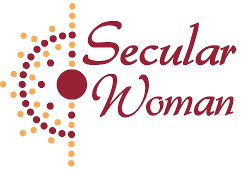4/13/2013: UPDATED***
Today, the leaders of several prominent secular organizations published a document titled “An Open Letter to the Secular Community.” Our name is not attached, and our members may be wondering why Secular Woman declined to endorse this document. As a secular organization, our mission is to amplify the voice, presence and influence of non-religious women. We recognize that part of our mission takes place in online communities. Although promoting better online communication is a worthy goal, we reject the current statement’s conception of civil discourse because we feel that it gives equal voice to the sexist ideas and beliefs that have been perpetuated as differing “interpretations” of feminism.
The Open Letter contains a textbook definition of feminism.
The principle that women and men should have equal rights flows from our core values as a movement . . . We seek not only civil equality for everyone, regardless of sex, but an end to discriminatory social structures and conventions – again often the legacy of our religious heritage—that limit opportunities for both women and men.
It is confusing, therefore, that this same letter suggests that a significant problem with online communication is centered on the “debate” about the “appropriate way to interpret feminism.” At Secular Woman, the principle that “feminism is a movement to end sexism, sexist exploitation, and oppression” (Hooks, 2000, p. viii) is taken as a given, and not a topic for debate.
As a secular feminist organization committed to understanding and exposing societal constructs that contribute to the inequality of women and other oppressed groups, we have no desire to listen to, respect, or continuously debunk overtly sexist viewpoints. Just as most scientists are not interested in debating the beliefs of creationists, we are not interested in debating gender-biased, racist, homophobic, or trans*phobic beliefs. Although the document contains reasonable recommendations for increasing effective communication, some of these techniques have been used to silence women (and other oppressed groups). When people express opinions that challenge sexism ingrained in social structures and conventions they receive a significant amount of pushback and harassment. Those of us working to challenge systemic sexism should be under no obligation to listen to or be more charitable to our opponents.
Sincerely,
The Board of Secular Woman
Kim Rippere, President
Elsa Roberts, Vice President
Corinne Zimmerman, Secretary
Brandon Chaddock
Nicole Harris
Charlotte Klasson
Monette Richards
UPDATE (4/15/13):
1. The idea that “feminism is a social movement to end sexism” is a textbook definition. We are not interested in participating in diversionary conversations about ‘gender feminism’ or ‘equity feminism’ or whether the SCUM Manifesto represents our definition of feminism. It does not.
Feminism – defined simply as being against sexism – is one of our values. As such, it informs the way we approach the mission, vision, and strategic goals of our volunteer organization.
Proving that feminism is a valid worldview is something Secular Woman is not interested in pursuing. What we are interested in pursuing is the strategic goals that we have set for our organization.
2. Because of our Response to the Open Letter, we have been criticized for not wanting to “listen to” or “be more charitable” to our opponents. This criticism suggests that we have shut down the dialog before even listening to the “opposing” side. The dialog concerning feminism and its role in atheism/secularism has been going on for some time now and we are aware of the great number of related conversations that have taken place in countless online forums, at secular conferences, and other venues. The formation of Secular Woman was a response to the ongoing “debate” about whether feminism has a place in the secular movement and community. We assert that it does. Because of this core value, we work from a viewpoint that takes the defining principles of feminism to be “self evident” (meaning we are not going to debate feminism’s validity; but are very open to discussions within a feminist framework).
Since conversations about the nuances of feminism are happening elsewhere, Secular Woman chooses to focus on its mission: promoting the voice and presence of non-religious women. We also choose to take the advice of Ron Lindsay (CFI President and CEO): "Or, if one thinks enough effort has been spent on rebuttal, simply ignoring them."
